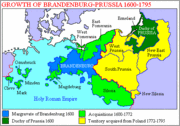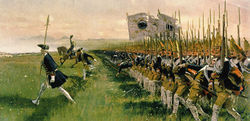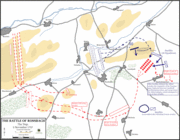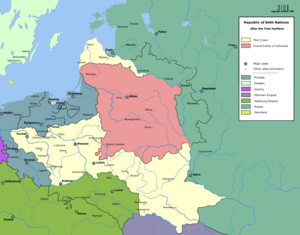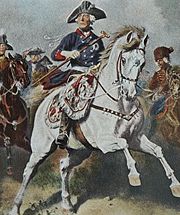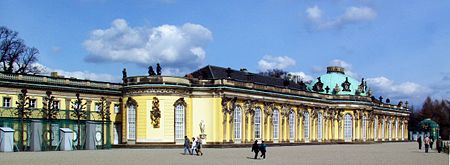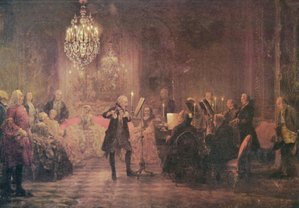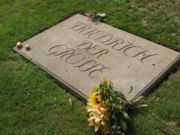Frederick II of Prussia
2008/9 Schools Wikipedia Selection. Related subjects: Historical figures
| Frederick II | |
| Frederick the Great, King of Prussia, Elector of Brandenburg | |
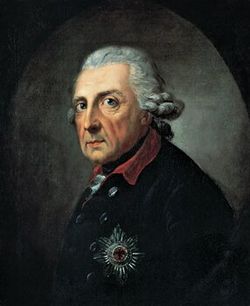 Frederick II, aged 68, by Anton Graff |
|
| Reign | 1740 - 1786 |
|---|---|
| Titles | Frederick II of Prussia Frederick IV of Brandenburg |
| Born | January 24, 1712 |
| Birthplace | Berlin, Prussia |
| Died | August 17, 1786 (aged 74) |
| Place of death | Potsdam, Prussia |
| Buried | Sanssouci, Potsdam |
| Predecessor | Frederick William I |
| Successor | Frederick William II |
| Consort | Elisabeth Christine of Brunswick-Bevern |
| Royal House | House of Hohenzollern |
| Father | Frederick William I |
| Mother | Sophia Dorothea of Hanover |
Frederick II (German: Friedrich II.; January 24, 1712 – August 17, 1786) was a King of Prussia (1740–1786) from the Hohenzollern dynasty. In his role as a prince-elector of the Holy Roman Empire, he was Frederick IV (Friedrich IV) of Brandenburg. He became known as Frederick the Great (Friedrich der Große) and was nicknamed der alte Fritz ("Old Fritz").
Interested primarily in the arts during his youth, Frederick unsuccessfully attempted to flee from his authoritarian father, the "Sargeant-King" Frederick William I, after which he was forced to watch the execution of a childhood friend. Upon ascending to the Prussian throne, he attacked Austria and claimed Silesia during the Silesian Wars, winning military acclaim for himself and Prussia. Near the end of his life, Frederick united most of his disconnected realm through the First Partition of Poland.
Frederick was a proponent of enlightened absolutism. For years he was a correspondent of Voltaire, with whom the king had an intimate, if turbulent, friendship. He modernized the Prussian bureaucracy and civil service and promoted religious tolerance throughout his realm. Frederick patronized the arts and philosophers. Frederick is buried at his favorite residence, Sanssouci in Potsdam. Because he died childless, Frederick was succeeded by his nephew, Frederick William II of Prussia, son of his brother, Prince Augustus William of Prussia.
Youth
Frederick was born in Berlin, the son of King Frederick William I of Prussia and Sophia Dorothea of Hanover. The so-called "Soldier-King", Frederick William had developed a formidable army and encouraged centralization, but was also known for his authoritarianism and temper. He would strike men in the face with his cane and kick women in the street, justifying his outbursts as religious righteousness. In contrast, Sophia was well-mannered and well-educated. Her father, George, Elector of Hanover, was the heir of Queen Anne of Great Britain. George succeeded as King George I of Great Britain in 1714.
The birth of Frederick was welcomed by his grandfather with more than usual pleasure, as two of his grandsons had already died at an early age. Frederick William wished his sons and daughters to be educated not as royalty, but as simple folk. He had been educated by a Frenchwoman, Madame de Montbail, who later became Madame de Rocoulle, and he wished that she should educate his children. Frederick was brought up by Huguenot governesses and tutors and learned French and German simultaneously.
Although Frederick William was raised a devout Calvinist, he feared he was not of the elect. To avoid the possibility of Frederick having the same motives, the king ordered that his heir not be taught about predestination. Although he was largely irreligious, Frederick adopted this tenet of Calvinism, despite the king's efforts. It is unknown if the crown prince did this to spite his father, or out of genuine religious belief.
Crown Prince
In early 1730, Queen Sophia Dorothea attempted to orchestrate a dual marriage of Frederick and his sister Wilhelmina with Amelia and Frederick, the children of King George II of Great Britain. Fearing an alliance between Prussia and Great Britain, Field Marshal von Seckendorff, the Austrian ambassador in Berlin, bribed Field Marshal von Grumbkow and Benjamin Reichenbach, the Prussian Minister of War and Prussian ambassador in London, respectively. The pair discreetly slandered the British and Prussian courts in the eyes of the two kings. Angered by the idea of the effete Frederick being so honored by Britain, Frederick William presented impossible demands to the British, such as Prussia acquiring Jülich and Berg, leading to the collapse of the marriage proposal.
Frederick found an ally in his sister, Wilhelmina, with whom he remained close for life. At age 16, Frederick had formed an attachment to the king's 13-year-old page, Peter Karl Christoph Keith. Wilhelmina recorded that the two "soon became inseparable. Keith was intelligent, but without education. He served my brother from feelings of real devotion, and kept him informed of all the king's actions."
When he was 18, Frederick plotted to flee to England with Hans Hermann von Katte and other junior army officers. While the royal retinue was near Mannheim in the Electoral Palatinate, Robert Keith, Peter's brother, had an attack of conscience when the conspirators were preparing to escape and begged Frederick William for forgiveness on August 5, 1730; Frederick and Katte were subsequently arrested and imprisoned in Küstrin. Because they were army officers who had tried to flee Prussia for Great Britain, Frederick William leveled an accusation of treason against the pair. The king threatened the crown prince with the death penalty, then considered forcing Frederick to renounce the succession in favour of his brother, Augustus William, although either option would have been difficult to justify to the Reichstag of the Holy Roman Empire. The king forced Frederick to watch the decapitation of his confidant Katte at Küstrin on November 6, leaving the crown prince to faint away and suffer hallucinations for the following two days.
Frederick was granted a royal pardon and released from his cell on November 18, although he remained stripped of his military rank. Instead of returning to Berlin, however, he was forced to remain in Küstrin and began rigorous schooling in statecraft and administration for the War and Estates Departments on November 20. Tensions eased slightly when Frederick William visited Küstrin a year later, and Frederick was allowed to visit Berlin on the occasion of his sister Wilhelmina's marriage to Margrave Frederick of Bayreuth on November 20, 1731. The crown prince returned to Berlin after finally being released from his tutelage at Küstrin on 26 February 1732.
Frederick William considered marrying Frederick to Elisabeth of Mecklenburg-Schwerin, the niece of Empress Anna of Russia, but this plan was ardently opposed by Prince Eugene of Savoy. Frederick himself proposed marrying Maria Theresa of Austria in return for renouncing the succession. Instead, Eugene persuaded Frederick William, through Seckendorff, that the crown prince should marry Elisabeth Christine of Brunswick-Bevern, a Protestant relative of the Austrian Habsburgs. Although Frederick wrote to his sister that, "There can be neither love nor friendship between us," and he considered suicide, he went along with the wedding on June 12, 1733. He had little in common with his bride and resented the political marriage as an example of the Austrian interference which had plagued Prussia since 1701. Once Frederick secured the throne in 1740, he prevented Elisabeth from visiting his court in Potsdam, granting her instead Schönhausen Palace and apartments at the Berliner Stadtschloss. Frederick bestowed the title of the heir to the throne, "Prince of Prussia", on his brother Augustus William; despite this, his wife remained devoted to him.
Frederick was restored to the Prussian Army as Colonel of the Regiment von der Goltz, stationed near Nauen and Neuruppin. When Prussia provided a contingent of troops to aid Austria during the War of the Polish Succession, Frederick studied under Prince Eugene of Savoy during the campaign against France on the Rhine. Frederick William, weakened by gout brought about by the campaign, granted Frederick Schloss Rheinsberg in Rheinsberg, north of Neuruppin. In Rheinsberg, Frederick assembled a small number of musicians, actors and other artists. He spent his time reading, watching dramatic plays, making and listening to music, and regarded this time as one of the happiest of his life. Frederick formed the " Bayard Order" to discuss warfare with his friends; Heinrich August de la Motte Fouqué was made the grand master of the gathering.
The works of Niccolò Machiavelli, such as The Prince, were considered a guideline for the behaviour of a king in Frederick's age. In 1739, Frederick finished his Anti-Machiavel — an idealistic writing in which he opposes Machiavelli. It was published anonymously in 1740, but Voltaire distributed it in Amsterdam to great popularity. Frederick's years dedicated to the arts instead of politics ended upon the 1740 death of Frederick William and his inheritance of the Kingdom of Prussia.
Kingship
Before his accession, Frederick was told by D'Alembert, "The philosophers and the men of letters in every land have long looked upon you, Sire, as their leader and model." Such devotion, however, had to be tempered by political realities. When Frederick ascended the throne as " King in Prussia" in 1740, Prussia consisted of scattered territories, including Cleves, Mark, and Ravensberg in the west of the Holy Roman Empire; Brandenburg, Hither Pomerania, and Farther Pomerania in the east of the Empire; and the former Duchy of Prussia, outside of the Empire bordering the Polish-Lithuanian Commonwealth. He was titled King in Prussia because this was only part of historic Prussia; he was to declare himself King of Prussia after acquiring most of the rest in 1772.
Warfare
Frederick's goal was to modernize and unite his vulnerably disconnected lands; toward this end, he fought wars mainly against Austria, whose Habsburg dynasty reigned as Holy Roman Emperors almost continuously from the 15th century until 1806. Frederick established Prussia as the fifth and smallest European great power by using the resources his frugal father had cultivated.
Desiring the prosperous Austrian province of Silesia, Frederick declined to endorse the Pragmatic Sanction of 1713, a legal mechanism to ensure the inheritance of the Habsburg domains by Maria Theresa of Austria. He was also worried that Augustus III, King of Poland and Elector of Saxony, would seek to connect his own disparate lands through Silesia. The Prussian king thus invaded Silesia the same year he took power, using as justification an obscure treaty from 1537 between the Hohenzollerns and the Piast dynasty of Brieg (Brzeg). The ensuing First Silesian War (1740–1742), part of the War of the Austrian Succession (1740–1748), resulted in Frederick conquering the province (with the exception of Austrian Silesia). Austria attempted to recover Silesia in the Second Silesian War (1744–1745), but Frederick was victorious again and forced Austria to adhere to the previous peace terms. Prussian possession of Silesia gave the kingdom control over the Oder River.
Habsburg Austria and Bourbon France, traditional enemies, allied together in the Diplomatic Revolution of 1756. As neighboring countries began conspiring against him, Frederick was determined to strike first. On August 29, 1756 his well-prepared army crossed the frontier and preemptively invaded Saxony, thus beginning the Seven Years' War (1756–1763). Facing a coalition which included Austria, France, Russia, Saxony, and Sweden, and having only Great Britain and Hanover as his allies, Frederick narrowly kept Prussia in the war despite having his territories frequently invaded. The sudden death of Empress Elizabeth of Russia, an event dubbed the miracle of the House of Brandenburg, led to the collapse of the anti-Prussian coalition. Although Frederick did not gain any territory in the ensuing Treaty of Hubertusburg, his ability to retain Silesia during the Silesian Wars made him and Prussia popular throughout many German-speaking territories.
Late in his life Frederick also involved Prussia in the low-scale War of the Bavarian Succession in 1778, in which he stifled Austrian attempts to exchange the Austrian Netherlands for Bavaria. When Emperor Joseph II tried the scheme again in 1784, Frederick created the Fürstenbund, allowing himself to be seen as a defender of German liberties, in contrast to his earlier role of attacking the imperial Habsburgs.
Frederick frequently led his military forces personally and had six horses shot from under him during battle. Frederick is often admired as one of the greatest tactical geniuses of all time, especially for his usage of the oblique order of battle. Even more important were his operational successes, especially preventing the unification of numerically superior opposing armies and being at the right place at the right time to keep enemy armies out of Prussian core territory. In a letter to his mother Maria Theresa, the Austrian co-ruler Emperor Joseph II wrote,
When the King of Prussia speaks on problems connected with the art of war, which he has studied intensively and on which he has read every conceivable book, then everything is taut, solid and uncommonly instructive. There are no circumlocutions, he gives factual and historical proof of the assertions he makes, for he is well versed in history… A genius and a man who talks admirably. But everything he says betrays the knave."
An example of the place that Frederick holds in history as a ruler is seen in Napoleon Bonaparte, who saw the Prussian king as the greatest tactical genius of all time; after Napoleon's defeat of the Fourth Coalition in 1807, he visited Frederick's tomb in Potsdam and remarked to his officers, "Gentlemen, if this man were still alive I would not be here".
Frederick the Great's most notable and decisive military victories on the battlefield were the Battles of Hohenfriedberg, Rossbach, and Leuthen.
First Partition of Poland
Empress Catherine II took the Imperial Russian throne in 1762 after the murder of her husband, Peter III. Catherine was staunchly opposed to Prussia, while Frederick disapproved of Russia, whose troops had been allowed to freely cross the Polish-Lithuanian Commonwealth during the Seven Years' War. Despite the two monarchs' dislike of each other, Frederick and Catherine signed a defensive alliance on April 11, 1764 which guaranteed Prussian control of Silesia in return for Prussian support for Russia against Austria or the Ottoman Empire. Catherine's candidate for the Polish throne, Stanisław August Poniatowski, was then elected King of Poland in September of that year.
Frederick became concerned, however, after Russia gained significant influence over Poland in the Repnin Sejm of 1767, an act which also threatened Austria and the Ottoman Turks. In the ensuing Russo-Turkish War (1768–1774), Frederick reluctantly supported Catherine with a subsidy of 300,000 roubles, as he did not want Russia to become even stronger through the acquisitions of Ottoman territory. The Prussian king achieved a rapprochement with Emperor Joseph and the Austrian chancellor Kaunitz. As early as 1731 Frederick had suggested in a letter to Field Marshal Dubislav Gneomar von Natzmer that the country would be well-served by annexing Polish Prussia in order to unite the eastern territories of the Kingdom of Prussia.
After Russia occupied the Danubian Principalities, Frederick's representative in Saint Petersburg, his brother Henry, convinced Frederick and Maria Theresa that the balance of power would be maintained by a tripartite division of the Polish-Lithuanian Commonwealth instead of Russia taking land from the Ottomans. In the First Partition of Poland in 1772, Frederick claimed most of the Polish province of Royal Prussia. Prussia annexed 20,000 mi² and 600,000 inhabitants, the least of the partitioning powers. However, the new West Prussia united East Prussia with Brandenburg and Hinterpommern and granted Prussia control of the mouth of the Vistula River. Although Maria Theresa had reluctantly agreed to the partition, Frederick commented, "she cries, but she takes".
Frederick quickly began improving the infrastructure of West Prussia, reforming its administrative and legal code, and improving the school system. Although Frederick despised the Polish nobility, or szlachta, he did befriend some Poles, such as Ignacy Krasicki, whom he asked to consecrate St. Hedwig's Cathedral in 1773. He also advised his successors to learn Polish, a policy followed by the Hohenzollern dynasty until Frederick III decided not to let William II learn the language.
Modernization
Frederick managed to transform Prussia from a European backwater to an economically strong and politically reformed state. His acquisition of Silesia was orchestrated so as to provide Prussia's fledgling industries with raw materials, and he protected these industries with high tariffs and minimal restrictions on internal trade. Canals were built, including between the Vistula and the Oder, swamps were drained for agricultural cultivation, and new crops, such as the potato and the turnip, were introduced. Frederick regarded his reclamation of land in the Oderbruch as a province conquered in peace. With the help of French experts, he reorganized the system of indirect taxes, which provided the state with more revenue than direct taxes. Frederick the Great commissioned Johann Ernst Gotzkowsky to promote the trade and - to take on the competition with France - put a silk factory where soon 1,500 persons found employment. Frederick the Great followed his recommendations in the field of toll levies and import restrictions. In 1763 when Gotzkowsky went broke during a financial crisis, which started in Amsterdam, Frederick took over his porcelain factory, known as KPM, but refused to buy more of his paintings.
During the reign of Frederick, the effects of the Seven Years' War and the gaining of Silesia greatly changed the economy. The circulation of depreciated money kept prices high. To revalue the Thaler, the Mint Edict of May 1763 was proposed. This stabilized the rates of depreciated coins that would be accepted and provided for the payments of taxes in currency of prewar value. This was replaced in northern Germany by the Reichsthaler, worth one-fourth of a Conventionsthaler. Prussia used a Thaler containing one-fourteenth of a Cologne mark of silver. Many other rulers soon followed the steps of Frederick in reforming their own currencies — this resulted in a shortage of ready money.
Frederick gave his state a modern bureaucracy whose mainstay until 1760 was the able War and Finance Minister Adam Ludwig von Blumenthal, succeeded in 1764 by his nephew Joachim who ran the ministry to the end of the reign and beyond. Prussia's education system was seen as one of the best in Europe. Frederick also abolished torture and corporal punishment.
Frederick began titling himself "King of Prussia" after the acquisition of Royal Prussia ( West Prussia) in 1772; the phrasing " King in Prussia" had been used since the coronation of Frederick I in Königsberg in 1701.
Religious tolerance
Frederick generally supported religious toleration, including the retention of Jesuits as teachers in Silesia, Warmia, and the Netze District after their suppression by Pope Clement XIV. He was interested in attracting a diversity of skills to his country, whether from Jesuit teachers, Huguenot citizens, or Jewish merchants and bankers, particularly from Spain. He wanted development throughout the country, specifically in areas that he judged as needing a particular kind of development. As an example of this practical-minded but not fully unprejudiced tolerance, Frederick wrote in his Testament politique that:
We have too many Jews in the towns. They are needed on the Polish border because in these areas Hebrews alone perform trade. As soon as you get away from the frontier, the Jews become a disadvantage, they form cliques, they deal in contraband and get up to all manner of rascally tricks which are detrimental to Christian burghers and merchants. I have never persecuted anyone from this or any other sect [sic]; I think, however, it would be prudent to pay attention, so that their numbers do not increase.
Jews on the Polish border were therefore encouraged to perform all the trade they could and received all the protection and support from the king as any other Prussian citizen. The success in integrating the Jews into those areas of society that Frederick encouraged them in can be seen by the role played by Gerson von Bleichröder in financing Bismarck's efforts to reunite Germany.
Frederick's religious tolerance seemed to be motivated by more than a simple ploy to achieve advancement for his country. At a time when much of Europe still keenly remembered the invasions of the Ottoman Empire in the 17th century, he said, "All religions are equal and good and as long as those practicing are an honest people and wish to populate our land, may they be Turks or Pagans, we will build them mosques and churches".
Architecture
Frederick had famous buildings constructed in his capital, Berlin, most of which still exist today, such as the Berlin State Opera, the Royal Library (today the State Library Berlin), St. Hedwig's Cathedral, and Prince Henry's Palace (now the site of Humboldt University). However, the king preferred spending his time in his summer residence Potsdam, where he built the palace of Sanssouci, the most important work of Northern German rococo. Sanssouci, which translates from French as "carefree" or "without worry", was a refuge for Frederick. " Frederician Rococo" developed under Georg Wenzeslaus von Knobelsdorff.
Music, arts, and learning
Frederick was a gifted musician who played the transverse flute. He composed 100 sonatas for the flute as well as four symphonies. The Hohenfriedberger Marsch, a military march, was supposedly written by Frederick to commemorate his victory in the Battle of Hohenfriedberg during the Second Silesian War. His court musicians included C. P. E. Bach, Johann Joachim Quantz, and Franz Benda. A meeting with Johann Sebastian Bach in 1747 in Potsdam led to Bach writing The Musical Offering.
Frederick also aspired to be a philosopher-king like the Roman emperor Marcus Aurelius. The king joined the Freemasons in 1738 and stood close to the French Enlightenment, admiring above all its greatest thinker, Voltaire, with whom he corresponded frequently. The personal friendship of Frederick and Voltaire came to an unpleasant end after Voltaire's visit to Berlin and Potsdam in 1750–1753, although they reconciled from afar in later years.
Frederick invited Joseph-Louis Lagrange to succeed Leonhard Euler at the Berlin Academy. Other writers attracted to the philosopher's kingdom were Francesco Algarotti, d'Argens, Julien Offray de La Mettrie, and Pierre Louis Maupertuis. Immanuel Kant published religious writings in Berlin which would have been censored elsewhere in Europe.
In addition to his native language, German, Frederick spoke French, English, Spanish, Portuguese, and Italian; he also understood Latin, ancient and modern Greek, and Hebrew. Preferring instead French culture, Frederick disliked the German language, literature, and culture, explaining that German authors "pile parenthesis upon parenthesis, and often you find only at the end of an entire page the verb on which depends the meaning of the whole sentence". His criticism led many German writers to attempt to impress Frederick with their writings in the German language and thus prove its worthiness. Many statesmen, including Baron vom und zum Stein, were also inspired by Frederick's statesmanship. Johann Wolfgang von Goethe gave his opinion of Frederick during a visit to Strasbourg (Strassburg) by writing:
Well we had not much to say in favour of the constitution of the Reich; we admitted that it consisted entirely of lawful misuses, but it rose therefore the higher over the present French constitution which is operating in a maze of lawful misuses, whose government displays its energies in the wrong places and therefore has to face the challenge that a thorough change in the state of affairs is widely prophesied. In contrast when we looked towards the north, from there shone Frederick, the Pole Star, around whom Germany, Europe, even the world seemed to turn…
Later years
Near the end of his life Frederick grew increasingly solitary. His circle of friends at Sanssouci gradually died off without replacements, and Frederick became increasingly critical and arbitrary, to the frustration of the civil service and officer corps. The populace of Berlin always cheered the king when he returned to the city from provincial tours or military reviews, but Frederick took no pleasure from his popularity with the common folk, preferring instead the company of his pet greyhounds, whom he referred to as his 'marquises de Pompadour' as a jibe at Madame de Pompadour. Frederick died in an armchair in his study in the palace of Sanssouci on 17 August 1786.
Frederick had wished to be buried next to his greyhounds on the vineyard terrace on the side of the corps de logis of Sanssouci. His nephew and successor Frederick William II instead ordered the body to be buried next to the grave of his father in the church of the Potsdam garrison. During World War II, the catafalques of both Frederick and Frederick William I were transferred first to an underground bunker, later to a mineshaft close to the town of Bernrode to protect them from destruction. In 1945 the US Army transported both kings first to the Elisabeth Church of Marburg and then on to Burg Hohenzollern close to the town of Hechingen. After German reunification, the body of Frederick William was entombed in the Kaiser Friedrich Mausoleum in Sanssouci's Church of Peace.
There was an emotional debate in Germany whether the funeral of a former king of Prussia, who was responsible for many wars during his time and who had been exploited as a symbol both by Nazi Germany and the German Democratic Republic, should be regarded as a public matter or not. Despite numerous protests, on the 205th anniversary of his death, on 17 August 1991, Frederick's casket lay in state in the court of honour of Sanssouci, covered by a Prussian flag and escorted by a Bundeswehr guard of honour. After nightfall, Frederick's body was finally laid to rest on the terrace of the vineyard of Sanssouci, according to his last will without pomp and at night ("... Im übrigen will ich, was meine Person anbetrifft, in Sanssouci beigesetzt werden, ohne Prunk, ohne Pomp und bei Nacht..." (1757))..
Legacy
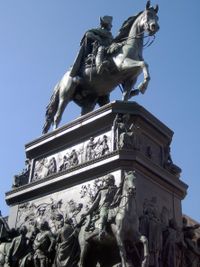
Frederick remains a controversial figure in Germany and Central Europe. With the rise of German romantic nationalism in the 19th century, Frederick was admired by German nationalists, even though he preferred French over German culture. In the 20th century, Frederick was often cited as a precursor for the Prussian and German militarism that would inspire Otto von Bismarck, William II and Adolf Hitler.
Unlike many of his contemporaries, Frederick did not believe in the Divine Right of Kings and, disregarding the exaggerated French style of the time, often wore old military uniforms; he merely believed the crown was "a hat that let the rain in". He called himself the "first servant of the state", but the Austrian empress Maria Theresa called him "the evil man in Sanssouci." His wars against Austria further weakened the Holy Roman Empire, yet gave to Prussia land and prestige that would prove vital for the 19th century unification of Germany. He was both an enlightened ruler and a ruthless despot. Through reform, war, and the First Partition of Poland, he turned the Kingdom of Prussia into a European great power.
Regarding Frederick, Lord Macaulay wrote:
If he had not made conquests as vast as those of Alexander, of Caesar, and of Napoleon, if he had not, on fields of battle, enjoyed the constant success of Marlborough and Wellington, he had yet given an example unrivalled in history of what capacity and resolution can effect against the greatest superiority of power and the utmost spite of fortune.
Frederick in popular culture
The armored frigate SMS Friedrich der Grosse (1874) and the battleship SMS Friedrich der Grosse (1911) were named after Frederick. King of Prussia, Pennsylvania, is named after the King of Prussia Inn, itself named in honour of Frederick.
In popular culture, Frederick has been included in the Civilization computer game series, the computer games Age of Empires III and Empire Earth II, and the board game Friedrich. In the 2004 German film Der Untergang, Adolf Hitler is shown sitting in a dark room forlornly gazing at a painting of Frederick shortly before taking his own life.
Ancestry
| Frederick William Elector of Brandenburg |
|
Louise Henriette of Orange-Nassau |
|
|
Ernest Augustus Elector of Brunswick-Lüneburg |
|
Sophia of the Palatine |
|
|
George William Duke of Brunswick-Lüneburg |
|
Eleonore d'Esmier d'Olbreuse |
|
||||||||||||||||||||||||||||||||||||||
|
|
|
|
|
|
|
||||||||||||||||||||||||||||||||||||||||||||||
|
|
|
|
|
|
|
|
|
|
|
|
|
|
|
|
|
|
|
|
|
|
|
|
|
|
|
|
|||||||||||||||||||||||||
|
|
|
|
|
|
|
|
|
||||||||||||||||||||||||||||||||||||||||||||
|
|
|
Frederick I of Prussia |
|
|
|
Sophia Charlotte of Hanover |
|
|
|
George I of Great Britain |
|
|
|
Sophia Dorothea of Celle |
|||||||||||||||||||||||||||||||||||||
|
|
|
|
|
|
|
|
|
||||||||||||||||||||||||||||||||||||||||||||
|
|
|
|
|
|
|
|
|
|
|
|
|
|
|
|
|
|
|
|
|
|
|||||||||||||||||||||||||||||||
|
|
|
|
|
|
Frederick William I of Prussia |
|
|
|
|
|
|
|
|
|
Sophia Dorothea of Hanover | ||||||||||||||||||||||||||||||||||||
|
|
|
|
|
|
|
|
|
|
|
||||||||||||||||||||||||||||||||||||||||||
|
|
|
|
|
|
|
|
|
|
|
|
Frederick II of Prussia | ||||||||||||||||||||||||||||||||||||||||

